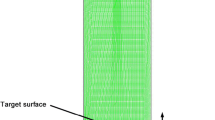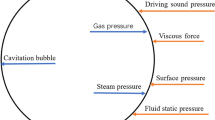Abstract
One of the prevalent material removal mechanisms in vibratory ultrasonic machining (USM) is cavitation erosion. The slurry-used USM process contains a mixture of water and abrasive particles—hence, strictly not pure cavitation. Cavitation erosion is the process of surface modification by generation and collapse of vapor bubbles on the workpiece surface inside a liquid medium. Although considerable research has been devoted in finding the material removal mechanism, rather less attention has been paid on the effect of pressure and temperature in cavitation erosion. Hence, efforts have been taken in this investigation to identify the mechanism of cavitation collapse at various ambient pressures and fluid temperatures and to investigate their effects in machining using AISI 304 stainless steel and aluminum 6061-T4 with wire EDM surface. Ambient pressure and temperature were varied from 100 to 400 kPa and 10 to 90 °C respectively. The outcomes showed that mass loss increased until 400 kPa and 50 °C and then declined with increase in liquid temperature. Scanning electron microscope (SEM) images showed that most of the test surface deformed plastically with surface undulations and material removal was by micro-pitting. Further, suggestions are provided to control the machining conditions from the identified cavitation collapse mechanism. Optimal conditions to accelerate the machining process were found to be 50 °C and 400 kPa.
Similar content being viewed by others
References
Zarepour H, Yeo SH, Tan PC, Aligiri E (2011) A new approach for force measurement and workpiece clamping in micro-ultrasonic machining. Int J Adv Manuf Technol 53(5):517–522. https://doi.org/10.1007/s00170-010-2845-6
Wang X, Zhou M, Gan JG-K, Ngoi B (2002) Theoretical and experimental studies of ultraprecision machining of brittle materials with ultrasonic vibration. Int J Adv Manuf Technol 20(2):99–102. https://doi.org/10.1007/s001700200130
Kumar J, Khamba JS (2010) Modeling the material removal rate in ultrasonic machining of titanium using dimensional analysis. Int J Adv Manuf Technol 48(1):103–119. https://doi.org/10.1007/s00170-009-2287-1
Karunamurthy B, Hadfield M, Vieillard C, Morales G (2010) Cavitation erosion in silicon nitride: experimental investigations on the mechanism of material degradation. Tribol Int 43(12):2251–2257. https://doi.org/10.1016/j.triboint.2010.06.012
Shchukin DG, Ekaterina S, Valentina B, Helmuth M (2011) Ultrasonic cavitation at solid surfaces. Adv Mater 23(17):1922–1934. https://doi.org/10.1002/adma.201004494
Hattori S, Itoh T (2011) Cavitation erosion resistance of plastics. Wear 271(7):1103–1108. https://doi.org/10.1016/j.wear.2011.05.012
Hammitt FG (1980) Cavitation and multiphase flow phenomena. McGraw-Hill Book Co
Kwok CT, Cheng FT, Man HC (2006) Cavitation erosion and corrosion behaviors of laser-aluminized mild steel. Surf Coat Technol 200(11):3544–3552. https://doi.org/10.1016/j.surfcoat.2004.12.016
Laguna-Camacho JR, Lewis R, Vite-Torres M, Méndez-Méndez JV (2013) A study of cavitation erosion on engineering materials. Wear 301(1):467–476. https://doi.org/10.1016/j.wear.2012.11.026
Dular M, Delgosha OC, Petkovšek M (2013) Observations of cavitation erosion pit formation. Ultrason Sonochem 20(4):1113–1120. https://doi.org/10.1016/j.ultsonch.2013.01.011
Zarepour H, Yeo SH (2012) Predictive modeling of material removal modes in micro ultrasonic machining. Int J Mach Tools Manuf 62(Supplement C):13–23. https://doi.org/10.1016/j.ijmachtools.2012.06.005
Hammitt FG, Rogers DO (1970) Effects of pressure and temperature variation in vibratory cavitation damage test. J Mech Eng Sci 12(6):432–439. https://doi.org/10.1243/JMES_JOUR_1970_012_072_02
Johnston J, Young S (1969) Effect of temperature and pressure on cavitation damage to a cobalt base alloy in sodium. NASA Technical note no TN D-5273. June 1969
Auret JG, Damm OFRA, Wright GJ, Robinson FPA (1993) Cavitation erosion of copper and aluminium in water at elevated temperature. Tribol Int 26(6):421–429. https://doi.org/10.1016/0301-679X(93)90082-C
Ahmed SM (1998) Investigation of the temperature effects on induced impact pressure and cavitation erosion. Wear 218(1):119–127. https://doi.org/10.1016/S0043-1648(97)00290-1
Abouel-Kasem A, El-Deen AE, Emara KM, Ahmed SM (2009) Investigation into cavitation erosion pits. J Tribol 131(3):031605. https://doi.org/10.1115/1.3075863
Huppertz P-H, Retter A (1980) Selection of materials for pressure vessels and chemical plants. Mater Werkst 11(4):124–133. https://doi.org/10.1002/mawe.19800110406
Li Z, Han J, Lu J, Zhou J, Chen J (2014) Vibratory cavitation erosion behavior of AISI 304 stainless steel in water at elevated temperatures. Wear 321:33–37. https://doi.org/10.1016/j.wear.2014.09.012
Lister DH, Davidson RD, McAlpine E (1987) The mechanism and kinetics of corrosion product release from stainless steel in lithiated high temperature water. Corros Sci 27(2):113–140. https://doi.org/10.1016/0010-938X(87)90068-0
ASTM G32-16 (2016) Standard test method for cavitation erosion using vibratory apparatus. ASTM International, West Conshohocken. https://doi.org/10.1520/G0032-16
Suslick KS, McNamara WB, Didenko Y (1999) Hot spot conditions during multi-bubble cavitation. In: Crum LA, Mason TJ, Reisse JL, Suslick KS (eds) Sonochemistry and sonoluminescence. Springer Netherlands, Dordrecht, pp 191–204. https://doi.org/10.1007/978-94-015-9215-4_16
Franc J-P, Riondet M, Karimi A, Chahine GL (2012) Material and velocity effects on cavitation erosion pitting. Wear 274-275:248–259. https://doi.org/10.1016/j.wear.2011.09.006
Iwai Y, Okada T, Hammitt FG (1983) Effect of temperature on the cavitation erosion of cast iron. Wear 85(2):181–191. https://doi.org/10.1016/0043-1648(83)90062-5
Author information
Authors and Affiliations
Corresponding author
Rights and permissions
About this article
Cite this article
Nagalingam, A.P., Yeo, S.H. Effects of ambient pressure and fluid temperature in ultrasonic cavitation machining. Int J Adv Manuf Technol 98, 2883–2894 (2018). https://doi.org/10.1007/s00170-018-2481-0
Received:
Accepted:
Published:
Issue Date:
DOI: https://doi.org/10.1007/s00170-018-2481-0




